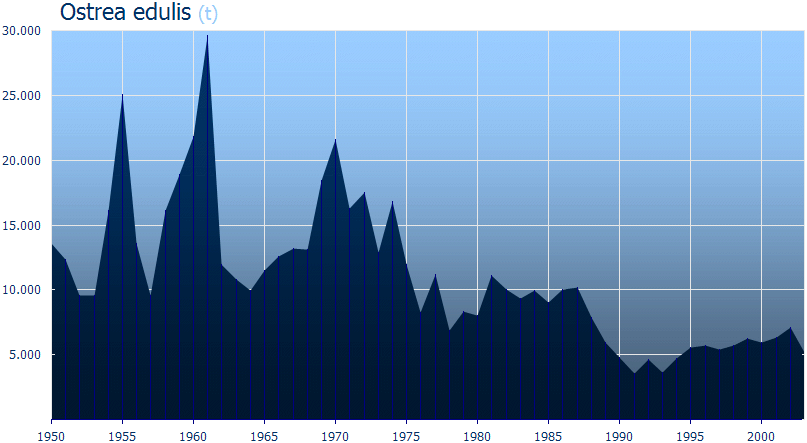European oyster
| European oyster | ||||||||||||
|---|---|---|---|---|---|---|---|---|---|---|---|---|

European oyster ( Ostrea edulis ), subfossil |
||||||||||||
| Systematics | ||||||||||||
|
||||||||||||
| Scientific name | ||||||||||||
| Ostrea edulis | ||||||||||||
| Linnaeus , 1758 |
The European oyster ( Ostrea edulis ) is a type of mussel from the oyster family (Ostreidae). It is grown on a small scale in aquaculture, but plays only a very minor role with a world market share of 0.2%. Therefore it is a relatively rare, but loved oyster specialty . It is called Huître plate (européenne) in French and European flat oyster in English . Particularly large specimens are called pied de cheval (horse's foot) in France . The European oyster had been extinct in the German part of the North Sea since around 1930. It has now been at home again since around 1992 in smaller stocks, which probably come from French breeders. But it is still threatened with extinction.
features
The shell of a European oyster is usually almost circular to slightly elliptical. They measure 12 to max. 18 cm in diameter (up to 20 cm). The keys are relatively flat, hence the French name plate . The left flap is slightly more arched than the right flap; the right flap effectively forms the cover for the left flap. They have grown firmly to the ground with the left flap and the external shape can vary accordingly. The outside of the flaps shows clear strips of growth and usually also strong radial ribs. The color is usually light gray, occasionally light brown or greenish with pink, greenish or reddish spots. The ligament lies inside in a triangular ligament pit. There is only one sphincter muscle. The lock has no teeth. The foot has largely regressed and there are no siphons either.
Way of life
The European oyster prefers to live in shallow coastal waters, it prefers bays with stable salinity and a firm subsoil. It occurs from the intertidal zone to about 80 m water depth. However, it does not form any benches, but rather lies occasionally at a distance of one to several meters. At low tide it can also fall dry; the flaps are tightly closed. However, the water must not be too cold; it needs at least 15 ° C in summer. The salt content must not be lower than 19 per thousand. It is extremely sensitive to water pollution and viral diseases and needs very clean water.
The European oyster is, in a sense, a hermaphrodite. However, she is not male and female at the same time, but changes sex several times in her life. Young animals are initially male and usually remain so in the first year. After that, they become female and change sex twice a year. The oysters spawn in summer when the water temperature is at least 15-17 degrees. The males simply release the sperm into the open water. The females produce up to 3 million eggs per spawning process, which are initially held back in the housing between the gills and fertilized by the sperm of male animals. After about two weeks, the larvae hatch and are expelled from the housing. They drift in open water for about a week or two before transitioning to bottom life. The losses during this time are enormous. The animal first attaches itself to a hard ground with the linen, before cementing the left flap to the hard ground with a putty-like mass formed by the foot. The foot is then largely regressed or does not grow any further. It is virtually no longer recognizable in the adult animal.
The European oyster grows much more slowly than z. B. the Pacific rock oyster . It can live up to 30 years.
Geographical distribution
As the name suggests, the European oyster is native to Europe . The distribution area extends on the eastern Atlantic coast of Norway to the level of the Mediterranean Sea. It is also found in the Mediterranean and Black Seas.
The European oyster as a seafood
The European oyster is fished on a relatively small scale as a seafood. The world market share is only about 0.2% of the world production of oysters. The largest producer is Spain with 2,400 tons (2003), followed by France (1,000 tons, 2005), Denmark , Great Britain and Ireland . Two thirds of the oysters come from aquaculture , one third is fished with scrap nets, the latter method being predominant in Denmark and England in particular . The number of European oysters has fallen sharply everywhere in the last few decades, and in many regions they have already died out in the wild.
The European oyster, when it is brought onto the market at the age of three to four years, is rather small compared to the other oyster species in the trade, the trade size is 8-11 cm.
Culinary
The huître plate is a relatively rare and expensive specialty, it is sought and appreciated by connoisseurs. It is practically always consumed raw. The best known type is the “Bélon” from the river Bélon of the same name on the south coast of Brittany ( France ), which is famous for its subtle and slightly nutty aroma. " Colchester ", "Helford" and "Whitstable" come from England and " Galway " from Ireland .
World annual production
- Annual production in tons (source: FAO / FIGIS)
Mollusk of the year
The European oyster was voted Mollusc of the Year 2013 by the Board of Trustees "Mollusc of the Year".
See also
swell
Individual evidence
literature
- Rainer Willmann: Mussels and snails of the North and Baltic Seas . JNN Naturführer, Neumann, Neudamm 1989 ISBN 3-7888-0555-2
Web links
- Information pages about oysters
- European oyster in the Wadden Sea Schutzstation Wattenmeer eV
- Information of FAO (Engl.)


